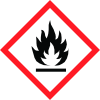Gram’s decolorizer solution
Sigma-Aldrich Chemie GmbH
Revision date : 2022-10-14


Note: Ingredients listed on restricted chemical lists
General Information
Revision date
2022-10-14
Product name
Gram’s decolorizer solution
REACH No
This
Emergency telephone
+49 (0)696 43508409
Icons in SDS
Company Information
Company name
Sigma-Aldrich Chemie GmbH
E-mail address of the competent person responsible for the Safety Data Sheet
technischerservice@merckgroup.com
GHS Information
Signal word
Danger
Hazard Codes
Hazard statements (CLP)
H225, H319, H336
Hazard statements
Code
Statements
H225
Highly Flammable liquid and vapour
H319
Causes serious eye irritation
H336
May cause drowsiness or dizziness
Precautionary statements
Code
Statements
P210
Keep away from heat, hot surface, sparks, open flames and other ignition sources. - No smoking.
P233
Keep container tightly closed.
P240
Ground/bond container and receiving equipment.
P241
Use explosion-proof [electrical/ventilating/lighting/.../] equipment.
P242
Use only non-sparking tools.
P305+P351+P338
IF IN EYES: Rinse cautiously with water for several minutes. Remove contact lenses if present and easy to do - continue rinsing.
EUH-statements
Code
Statements
EUH066
Repeated exposure may cause skin dryness or cracking
Section 2
2.1 Classification of the substance or mixture
Classification
2.2 Label elements
Labelling
Signal word
Danger Danger
Hazard statements
H225 Highly flammable liquid and vapor. H319 Causes serious eye irritation. H336 May cause drowsiness or dizziness. none
Precautionary statements
P210 Keep away from heat, hot surfaces, sparks, open flames and other ignition sources. No smoking. P233 Keep container tightly closed. P240 Ground and bond container and receiving equipment. P241 Use explosion-proof electrical/ ventilating/ lighting/ equipment. P242 Use non-sparking tools. P305 + P351 + P338 IF IN EYES: Rinse cautiously with water for several minutes. Remove contact lenses, if present and easy to do. Continue rinsing. none
Supplemental label elements
EUH066 Repeated exposure may cause skin dryness or cracking. Reduced Labeling (<= 125 ml) EUH066 Repeated exposure may cause skin dryness or cracking.
2.3 Other hazards
This substance/mixture contains no components considered to be either persistent, bioaccumulative and toxic (PBT), or very persistent and very bioaccumulative (vPvB) at levels of 0.1% or higher.

